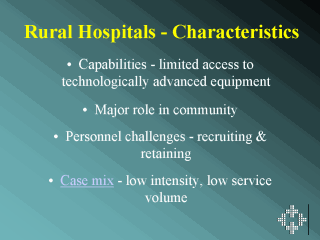| front |1 |2 |3 |4 |5 |6 |7 |8 |9 |10 |11 |12 |13 |14 |15 |16 |17 |18 |19 |20 |21 |22 |23 |review |
 |
Comparative data
on hospital performance can serve as valuable benchmarks for hospital administrators -
some hospitals may be able to serve as models for other hospitals to emulate. Performance evaluations of rural hospitals must be sensitive to their differences from urban hospitals. Development of hospital-based indicators suited for rural hospitals should be a collaborative effort between researchers and key stakeholders. These indicators may also help guide analyses. For example, because of the low volume of cases handled by rural hospitals, Stewart et al (2000)10 based their performance analysis on a three-year average (fiscal years 1996-1998) rather than on a single year. Combining a population-based perspective (how much hospital care populations are using, weighed against their need) with measures of individual hospital performance provides health planners with comprehensive data to make informed decisions about the patterns of use of various hospitals in their regions. |